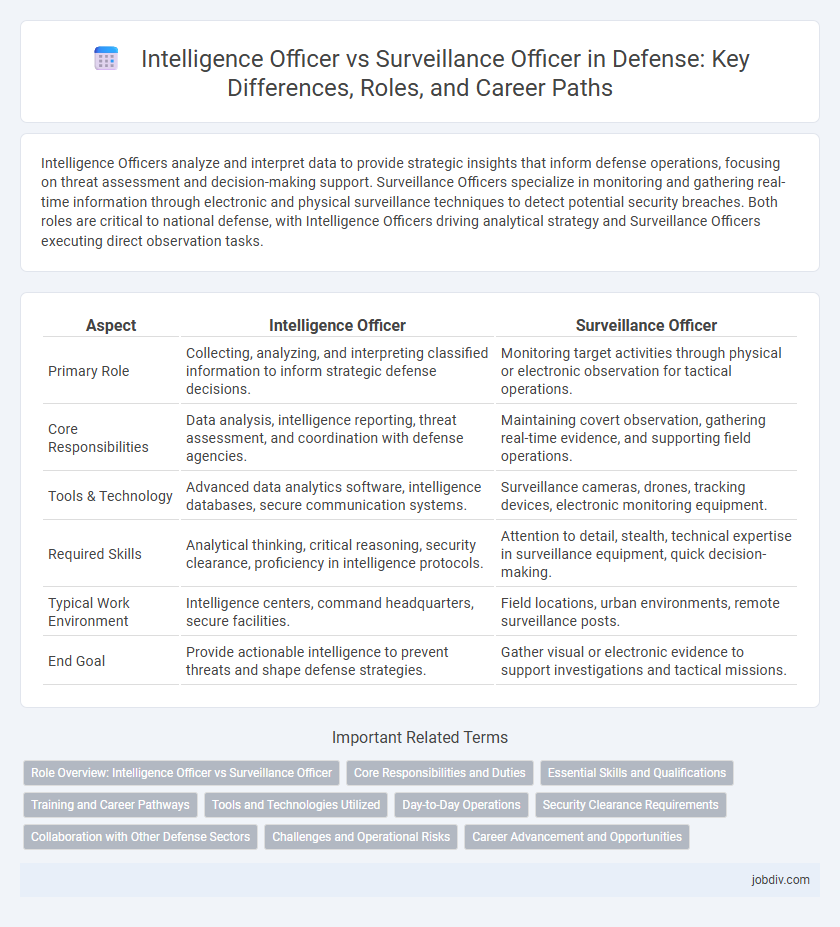Intelligence Officers analyze and interpret data to provide strategic insights that inform defense operations, focusing on threat assessment and decision-making support. Surveillance Officers specialize in monitoring and gathering real-time information through electronic and physical surveillance techniques to detect potential security breaches. Both roles are critical to national defense, with Intelligence Officers driving analytical strategy and Surveillance Officers executing direct observation tasks.
Table of Comparison
| Aspect | Intelligence Officer | Surveillance Officer |
|---|---|---|
| Primary Role | Collecting, analyzing, and interpreting classified information to inform strategic defense decisions. | Monitoring target activities through physical or electronic observation for tactical operations. |
| Core Responsibilities | Data analysis, intelligence reporting, threat assessment, and coordination with defense agencies. | Maintaining covert observation, gathering real-time evidence, and supporting field operations. |
| Tools & Technology | Advanced data analytics software, intelligence databases, secure communication systems. | Surveillance cameras, drones, tracking devices, electronic monitoring equipment. |
| Required Skills | Analytical thinking, critical reasoning, security clearance, proficiency in intelligence protocols. | Attention to detail, stealth, technical expertise in surveillance equipment, quick decision-making. |
| Typical Work Environment | Intelligence centers, command headquarters, secure facilities. | Field locations, urban environments, remote surveillance posts. |
| End Goal | Provide actionable intelligence to prevent threats and shape defense strategies. | Gather visual or electronic evidence to support investigations and tactical missions. |
Role Overview: Intelligence Officer vs Surveillance Officer
An Intelligence Officer analyzes and interprets data from multiple sources to provide actionable insights for strategic decision-making in defense operations. A Surveillance Officer focuses on monitoring and collecting real-time information through electronic and physical surveillance techniques to detect and track potential threats. Both roles are critical for national security, with Intelligence Officers synthesizing intelligence reports and Surveillance Officers ensuring continuous situational awareness.
Core Responsibilities and Duties
Intelligence Officers analyze and interpret data to provide actionable insights for strategic decision-making, focusing on threat assessment, enemy capabilities, and mission planning. Surveillance Officers gather real-time information through monitoring technologies and human observation, emphasizing the collection of field intelligence to support operational security. Both roles are critical for defense operations, with Intelligence Officers concentrating on analysis and Surveillance Officers on data acquisition.
Essential Skills and Qualifications
Intelligence Officers require strong analytical skills, proficiency in data interpretation, and expertise in strategic planning to assess and predict potential threats. Surveillance Officers must excel in observation, technical proficiency with surveillance equipment, and real-time information gathering to monitor activities effectively. Both roles demand a security clearance, attention to detail, and the ability to operate under high-pressure environments in defense operations.
Training and Career Pathways
Intelligence Officers undergo rigorous training in data analysis, threat assessment, and strategic planning, often involving advanced degrees in intelligence studies or security management. Surveillance Officers receive specialized training in covert operations, electronic monitoring, and field surveillance techniques, typically starting with law enforcement or military experience. Career pathways for Intelligence Officers often lead to strategic roles in national security agencies, whereas Surveillance Officers focus on tactical roles in counterintelligence and operational support units.
Tools and Technologies Utilized
Intelligence Officers leverage advanced data analytics platforms, signal interception tools, and AI-driven predictive models to gather and interpret complex information for strategic decision-making. Surveillance Officers utilize high-resolution cameras, drones, thermal imaging, and electronic monitoring devices to conduct real-time observation and tracking of targets in operational environments. Both roles depend on integrated communication systems and secure networks to ensure accurate data transmission and mission effectiveness.
Day-to-Day Operations
Intelligence Officers analyze data from multiple sources to generate actionable insights, focusing on strategic threat assessment and decision support. Surveillance Officers conduct continuous monitoring using advanced technology such as CCTV, drones, and signal intercepts to track targets and gather real-time information. Collaboration between these roles ensures comprehensive security intelligence and effective operational responses.
Security Clearance Requirements
Intelligence Officers typically require higher-level security clearances such as Top Secret or SCI due to access to sensitive national security information. Surveillance Officers often hold Secret or Confidential clearances, enabling them to conduct field operations with restricted but critical data. Clearance levels are determined by the sensitivity of information handled and the potential impact on defense operations.
Collaboration with Other Defense Sectors
Intelligence Officers play a critical role in analyzing data and sharing actionable insights with Surveillance Officers to enhance real-time threat detection and neutralization. Surveillance Officers contribute by providing live operational feedback and detailed reconnaissance, enabling Intelligence Officers to refine risk assessments and strategic planning. Effective collaboration between these roles ensures comprehensive situational awareness and improves coordination across defense sectors such as cybersecurity, signals intelligence, and field operations.
Challenges and Operational Risks
Intelligence Officers face challenges in analyzing vast, complex data sets to produce actionable insights while mitigating the risk of misinformation that can compromise mission success. Surveillance Officers encounter operational risks related to maintaining covert positions and avoiding detection, which can jeopardize both personal safety and mission integrity. Both roles require rigorous adherence to security protocols and situational awareness to navigate dynamic environments and evolving threat landscapes effectively.
Career Advancement and Opportunities
Intelligence officers often experience faster career advancement due to their critical role in analyzing complex data and shaping strategic decisions, leading to higher-ranking positions within defense agencies. Surveillance officers typically advance through operational expertise, gaining opportunities in field leadership and technical specialization, but may face slower progression compared to intelligence roles. Both career paths offer unique opportunities for specialization, with intelligence officers gravitating towards analytical and policy positions, while surveillance officers excel in tactical and technological fields.
Intelligence Officer vs Surveillance Officer Infographic

 jobdiv.com
jobdiv.com